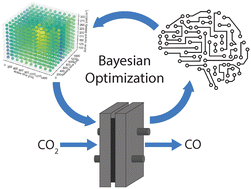Bayesian optimization of electrochemical devices for electrons-to-molecules conversions: the case of pulsed CO2 electroreduction†
Abstract
Electrons-to-molecules conversions have emerged as a route to integrate renewable electricity into chemical production processes and ultimately contribute to the decarbonization of chemistry. The practical implementation of these conversions will depend on the optimization of many electrolyzer design and operating parameters. Bayesian optimization (BO) has been shown to be a robust and efficient method for these types of optimization problems where data may be scarce. Here, we demonstrate the use of BO to improve a membrane electrode assembly (MEA) CO2 electrolyzer, targeting the production of CO through dynamic operation. In a system with intentionally unoptimized components, we first demonstrate the effectiveness of dynamic voltage pulses on CO faradaic efficiency (FE), then utilize BO for 3D and 4D optimization of pulse times and current densities to increase CO partial current density by >64% from the initially tested conditions. The methodology showcased here lays the groundwork for the optimization of other complex electrons-to-molecules conversions that will be required for the electrification of chemical manufacturing.



 Please wait while we load your content...
Please wait while we load your content...
